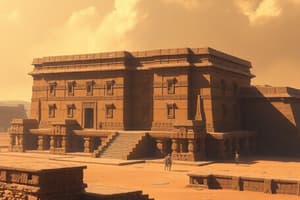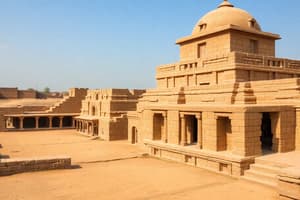Podcast
Questions and Answers
किस नदी के किनारे मोहेंजो-दाड़ो स्थित है?
किस नदी के किनारे मोहेंजो-दाड़ो स्थित है?
सिंधु नदी
इंडस वैली सभ्यता के स्थापक और ग्रंथिक क्या थे?
इंडस वैली सभ्यता के स्थापक और ग्रंथिक क्या थे?
मोहेंजो-दाड़ो
मोहेंजो-दाड़ो के खोजावस्तु से संबंधित सूचना क्या प्रदान करते हैं?
मोहेंजो-दाड़ो के खोजावस्तु से संबंधित सूचना क्या प्रदान करते हैं?
जानवरों के चित्र और खाता-पुस्तिका के उपयोग
इंडस वैली सभ्यता की समाप्ति के बारे में क्या विचार हैं?
इंडस वैली सभ्यता की समाप्ति के बारे में क्या विचार हैं?
किस नदी के सुखाने से इंडस वैली सभ्यता की समाप्ति हो सकती थी?
किस नदी के सुखाने से इंडस वैली सभ्यता की समाप्ति हो सकती थी?
मोहनजोदड़ो की विशेषताएँ किस प्रकार स्थापित की गईं थीं?
मोहनजोदड़ो की विशेषताएँ किस प्रकार स्थापित की गईं थीं?
मोहनजोदड़ो में कौशल का साक्षात्कार किस प्रकार किया गया था?
मोहनजोदड़ो में कौशल का साक्षात्कार किस प्रकार किया गया था?
मोहनजोदड़ो की महत्वपूर्ण सार्वजनिक इमारत कौन-कौन सी थीं?
मोहनजोदड़ो की महत्वपूर्ण सार्वजनिक इमारत कौन-कौन सी थीं?
हिंदुस्थानी सभ्यता किस क्षेत्र को समायोजित करती थी?
हिंदुस्थानी सभ्यता किस क्षेत्र को समायोजित करती थी?
मोहनजोदड़ो में कौशलिकता का प्रमाण किस तरह किया गया है?
मोहनजोदड़ो में कौशलिकता का प्रमाण किस तरह किया गया है?
Flashcards are hidden until you start studying
Study Notes
Bharat ki Khoj: The Indus Valley Civilization and Mohenjo-Daro
The Indus Valley Civilization, spanning from around 2600 BCE to 1900 BCE, was a pivotal era in South Asian history that left a lasting impact on our understanding of ancient civilizations. One of its most renowned and well-preserved settlements, Mohenjo-Daro, offers a unique window into this fascinating epoch.
Mohenjo-Daro
Mohenjo-Daro, situated in modern-day Pakistan, was once a thriving metropolis with a population of around 40,000 to 50,000, making it one of the largest urban settlements of its time. The city was organized into a grid system of wide streets and well-planned neighborhoods, with sophisticated sanitation systems, including a sophisticated drainage network, and public baths. In its 400-acre expanse, Mohenjo-Daro featured large public buildings, such as the Great Bath—a massive brick structure believed to be used for religious rituals and social gatherings.
Archaeologists have uncovered evidence of an advanced culture at Mohenjo-Daro, including the use of standard weights and measures, seals with complex scripts, and an intricate system of trade and commerce. The city's artifacts, such as pottery, seals, and jewelry, exhibit a high level of craftsmanship and creativity.
The Indus Valley Civilization
The Indus Valley Civilization spanned a vast region, including areas of modern-day India, Pakistan, and Afghanistan. It was characterized by a complex and interconnected network of cities, towns, and agricultural settlements. The civilization's material culture, including pottery, seals, and metallurgy, displays a high level of sophistication and standardization, indicating a centralized and organized society.
The Indus Valley Civilization's script, known as the Indus script, has yet to be fully deciphered, but it shows a high level of complexity and sophistication. The script's symbols and the layout of Indus cities suggest a complex and organized society, with a system of writing and record-keeping.
Trade and Commerce
The Indus Valley Civilization was known for its extensive trade networks. Archaeological evidence suggests the civilization traded with Mesopotamia, Elam, and the Persian Gulf regions. Mohenjo-Daro's location on the banks of the Indus River made it an ideal location for trade, as it connected the city to the river's vast network of tributaries.
The civilization's standardized weights and measures suggest a sophisticated system of trade and commerce. Seals found at Indus Valley sites, many containing depictions of animals, bulls, and other symbols, were likely used for accounting purposes, indicating a high degree of organization and record-keeping.
Decline and Legacy
The Indus Valley Civilization's decline is still a topic of debate among archaeologists. Some theories suggest environmental factors, such as the drying of the Saraswati River, led to the civilization's decline. Others argue that invasions or social and economic changes may have played a role.
Despite its decline, the Indus Valley Civilization left a lasting legacy. Its highly organized urban planning, standardized weights and measures, and complex script have inspired and influenced various aspects of modern society. Mohenjo-Daro, with its elaborate architecture and sophisticated water management systems, remains an invaluable source of information and inspiration for modern architects and urban planners.
The Indus Valley Civilization's rich legacy reminds us of the complexity and sophistication of ancient civilizations, and the lessons they can teach us about the development of human societies. As we continue to unravel the mysteries of this fascinating era, we can better understand our own history and appreciate the rich cultural heritage of South Asia.
Studying That Suits You
Use AI to generate personalized quizzes and flashcards to suit your learning preferences.




